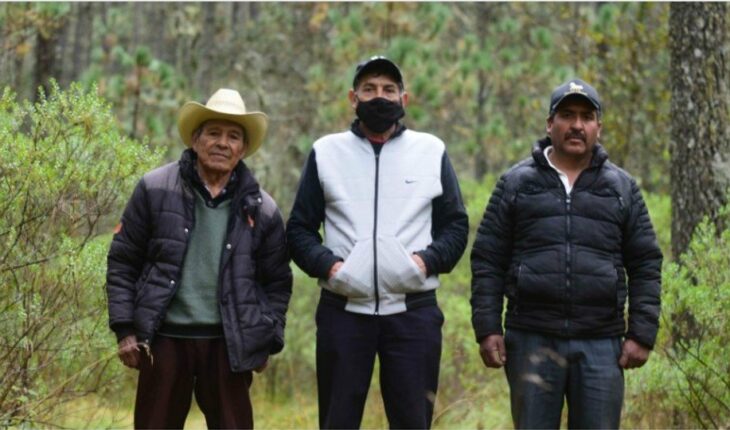When Leopoldo Chávez Hernández was fifteen, the leafy trees that now surround him measured less than two meters and were just beginning to fill the space left by the previous forest, after being razed by fire and logging. “Pretend,” he says, “that they were like a corn planting, even, there was only one or another big tree.”
Leopoldo Chavez is about to turn 82. His memory and physical condition are remarkable, especially when he walks with agility on these paths. The man says that, for almost 70 years, the inhabitants of the Ejido Agua de los Pescados have preserved 599 hectares of pines and oyameles, an area similar to that occupied by almost 800 soccer fields.
The forest area that Leopoldo Chávez now runs through is known as Agua Escondida and is part of the Cofre de Perote National Park. In this place, which is part of the Pixquiac basin, are the springs where 38% of the water flows that, 50 kilometers away, are used by the nearly half a million inhabitants of the city of Xalapa, in the state of Veracruz.
Water boxes where the springs that supply 38% of the water that reaches Xalapa are concentrated. Photo: Óscar Martínez.
Decades ago the community, in assembly, decided to ban the grazing of animals within the forest. And, for a few years now, they organized surveillance rounds to prevent logging.
“We can’t tear down the forest because we support ourselves for anything,” says Chávez, who is the ejido commissioner of Agua de los Pescados.
The inhabitants of the ejido take care of this forest area with zeal. They have every reason to do so. The forest not only gives them the firewood they occupy to face the low temperatures that dominate in this region, it also allows them to have income from ecotourism, from the sale of the wood they produce in a sustainable way or from the payment of environmental services.
Since 2007, 108 ejidatarios of Agua de los Pescados began to receive financial compensation from the National Forestry Commission (Conafor) for conserving the forests that allow the inhabitants of Xalapa to bring water. In 2011, the community joined the Pixquiac River Basin Committee (Cocupix), an organization that continued with the compensation for hydrological environmental services.
Location of the Ejido Agua de Los Pescados.
Trees among potatoes
Leopoldo Chávez recalls that, in 1937, just two months after the ejido was created and endowed with its lands, the decree creating a national park around the Cofre de Perote was published, a volcano that with its 4,282 meters of altitude is the eighth highest in the country.
With the decree an imaginary line was painted on the map that placed 1269 hectares, almost the entire territory of the agua de Los Pescadores ejido, within the protected natural area; the rest, 353, were left out.
When the expropriation of land for the park was carried out, no authority noticed that 800 hectares of the ejido, dedicated to potato cultivation, remained within the park and, therefore, there that activity could no longer be carried out.
In the Perote region there are more than 300 potato producers. Photo: Óscar Martínez
In the end, the ejidatarios reached an agreement with the federal authorities to respect the planting areas. The same happened with ten other ejidos with lands within the protected natural area. That caused that, over time, in the place there is an image of contrasts: areas where the green of the pines and oyameles predominates, but which are surrounded by large deforested areas dedicated to the planting of potatoes.
Read: Mexico: The shadow of mining haunts the future of community forests
Raúl Álvarez Oceguera, director of the Cofre de Perote National Park, estimates that within the natural area there are at least 5 thousand hectares dedicated to the cultivation of potatoes, oats, chickpeas, beans, wheat and fodder.
In Agua de Los Pescados, potato planting is not over. However, unlike several of his neighbors, in this community of just over two thousand inhabitants he decided to stop the expansion of cultivation and conserve almost 600 hectares of forest. And for this reason, Álvarez recognizes this community as an example of the sustainable management of forest resources.
Jidatarios de Agua de los Pescados. Photo: community archive.
Paying to take care of water sources
Arriving at the area known as Agua Escondida, Leopoldo Chávez shows the place where the springs are still alive thanks to the forest that the ejido preserves. Metal lids protect the infrastructure that was built to bring the water that flows in these lands to the city of Xalapa, as well as to the communities of Los Pescados, Rancho Viejo and El Zapotal.
“We,” he explains. Chavez—we were already taking care of the forest when in 2011 the Sendas organization came to lend us a hand. Now we are being rewarded for the water we send to the city.”
The ejido commissioner speaks of an initiative that began in 2006, when the civil association Senderos y Encuentros para un Desarrollo Autónomo Sustentable (Sendas) and other environmental organizations created the Pixquiac River Basin Committee (Cocupix), to promote the good management of natural resources and the integral development of the inhabitants of the basin.
Signs on the forest road asking for your care. Photo: Óscar Martínez.
To achieve their objectives, the members of Cocupix decided to launch the Compensation Program for Environmental Services, which consists of paying the communities that conserve the forest.
The payment of environmental services, technical assistance, monitoring of fauna and flora conservation agreements, is paid with resources from the National Forestry Commission and the Municipal Water Commission of Xalapa (Cmas), where the Pixquiac River Basin Committee (Cocupix) is co-signatory.
The ejidatarios of Agua de Los Pescados obtain this payment since 2007 with Conafor; in 2010, in assembly, they decided to move to Cocupix, where the resources of Conafor are added to the local ones, providing more resources per hectare. In 2021, they signed a new five-year agreement to receive 1300 pesos (about $63) per hectare of forest they conserve.
Agua Escondida, place where springs sprout. Photo: Óscar Martínez.
For Hectór Mota Velazco, who is in charge of the National Forestry Commission (Conafor) in Veracruz, the inhabitants of this ejido are “the guardians of the city’s water.” The payment of environmental services, he emphasizes, is “the recognition of society to the work of peasants in the mountains. When we are in the city we open the tap and we want (the water) to never run out, but we don’t ask where it comes from, so paying for this is a recognition to the communities.”
Georgina Vidriales Chang, from Sendas and member of the basin committee, emphasizes that “it cannot be just resource extraction, there has to be an exchange of benefits between the countryside and the city. Although we start campaigns to raise awareness, it is necessary to permeate more in society so that they know where the water comes from.”
The agua de Los Pescados ejido is not the only one that receives this payment for environmental services: within the program there are a total of 1474 hectares, located in the Pixquiac basin, which belong to ejidos, communities and private conservation properties.
“Veracruz has been a pioneer in environmental services for almost 20 years. The Coatepecano Trust for the Conservation of Forest and Water (Fidecoagua,) which conserves the El Gavilán basin in the mountain mesophile forest, in the central region of the state, was the first to charge water bills for environmental services. We are an example,” says Conafor representative Mota Velazco.
Pixquiac River Basin.
Guards to stop logging
Leopoldo Chávez, ejido commissioner; Juan Gabriel Monfil, of the surveillance commission and Martín Sánchez Durán, treasurer of the assembly, show Mongabay Latam the work carried out by the ejidatarios to keep the forest in good condition.
Those who walk along these paths encounter different species of trees such as the chamaite (Pinus montezumae), the red pine (Pinus patella), the acalocote (Pinus ayacahuite) and oak (Quercus spp.).
The ejidatarios show the firebreaks – roads in the middle of the forest – that they have built so that, in case of a fire, its spread can be stopped. In its last count, more than 16 kilometers of gaps were recorded around the park. In addition, they monitor flora and fauna.
Inside the forest you can see signs about the care and conservation of the forest. Photo: Óscar Martínez.
Around the forest there are signs warning that they are “protected forest plots”. That has not stopped those who carry out clandestine logging. That is why surveillance is one of the main tasks of the ejido. Gabriel Monfil, of the surveillance committee, explains that every day, between six and seven people do night guards: from midnight, they go up into the forest.
While walking through the forest, Chávez does not stop observing the marks on the earth, he says that they are the footprints of the horses: “You can see that they came to loiter, you have to be careful here, they have already come to see what they take,” he tells the ejidatarios.
Read: The likelihood of another forest destruction pandemic is ‘greater than ever’: experts
Between 2001 and 2020, Cofre de Perote National Park lost 116 hectareas of tree cover, according to the analysis of satellite images of the Global Forest Watch platform. In addition, from 2015 to December 2021, 121 alerts for deforestation have been registered.
Throughout 2021, Profepa counted six complaints of tree demolition, according to information obtained through transparency. In March of that year, the management of the national park filed a complaint for illegal logging in the Agrícola Progreso colony, located inside the protected natural area.
Leopoldo Chávez Hernández accompanied by other ejidatarios. Photo: Óscar Martínez.
Living from forest management
The ejido Agua de los Pescadores is located at just over 3 thousand meters of altitude. The locals are engaged in potato production of various varieties, planting corn, raising sheep and supplementing their income with sustainable forest management.
In addition to receiving payment for environmental services, the ejidatarios have a forest management program — for the 75.7 hectares of their forest that are not within the national park — which allows them to produce wood in a sustainable way.
Forest management operations are carried out under a low-impact silvicultural system and a responsible practice. Its forest management program was approved by the Ministry of Environment and Natural Resources (Semarnat) until 2024 with ten annuities of 1,159 cubic meters each.
The forest use of the ejido is distributed in small areas of the forest and represents 4.6% of the total area of its territory.
Pine and oyamel forest in the agua de Los Pescados ejido in the Cofre de Perote National Park. Photo Óscar Martínez.
The ejidatarios comment that they would like to incorporate more areas of land into forest management, but they know that they have as a limitation being within a protected natural area, so the only option they have to obtain more economic resources is to increase the payment for environmental services.
María Luisa León Mateos, in charge of the Forests and Water program of the civil association Sendas, explains that along with the care of the forest, the community has promoted productive ecotourism projects, family gardens, marketing strategies for agroecological products, among others.
The ejido, for example, is part of the Route of the Cofre de Perote, an ecotourism hiking project within the protected natural area. They also started a water purifier obtained from one of its springs, although for three years it has not worked due to the lack of inputs; the plans are to reactivate it in the coming months.
Martín Sánchez Durán proudly shows the forest they have protected. Photo: Óscar Martínez.
Community work, says León Mateos, has helped peasants “take the reins” of the care of the forest and water: “Before they were dissatisfied, because they did not receive anything to take care of the forest, now their gaze has changed. They do daily surveillance to avoid logging, they take agreements in assembly to avoid simulation in care and between them they monitor each other for proper conservation.”
One of the projects that has gained more strength is the aroma de Montaña cooperative, created five years ago and integrated by ten women who managed to create a “living pharmacy” with the production and transformation of aromatic and medicinal plants of the forest.
“We make ointment, soaps, creams, shampoo, antibacterial gel, tea bags and oils, and we market them to support the family economy,” explains Blanca Estela Pérez Salazar, a member of the cooperative.
The women transformed six hectares of potato planting into a forest area. They planted pine trees and, at the end of 2021, marketed some of them as Christmas trees. The trees are planted among vegetables and medicinal plants.
Members of the aroma mountain cooperative. Photo: Courtesy of the community.
Betting on agroecology
The fact that women decided to change potato production for planting trees is no small thing, especially in an area where the cultivation of the tuber has taken root for several decades. Today there are about 300 producers in the region.
In these lands, potato planting became popular in the eighties and with it also came the excessive use of agrochemicals to achieve faster harvests.
The installation of the Pixquiac River Basin Committee (Cocupix) also led some producers to try ecological methods to plant potatoes free of agrotoxins. Although the project is incipient — just five hectares in the area — it has already generated the curiosity of several farmers.
In the agua de los Pescados ejido there are extensions of land dedicated to potato cultivation. Photo: Óscar Martínez.
Humberto Chávez, a member of the ejido’s fire brigade, decided to break with the traditional cultivation methods that his family followed for 40 years and opted for the production of potatoes free of agrotoxics. Today it grows on two hectares, has its own organic fertilizer biofactory and has achieved yields higher than those of traditional producers.
The case of the Agua de Los Pescados ejido is serving as an example for other communities in the region to be encouraged to design a plan to take care of their forest. One of them is the community of Tembladeras —located 7 kilometers from the ejido, in the municipality of Xico and also within the Cofre de Perote National Park—, in whose territory there are springs that also grant water to the city of Xalapa.
Georgina Vidriales Chang, from Sendas, assures that in 2022, Tembladeras will be added with 200 hectares of environmental conservation within the Pixquiac basin.
Agua de Los Pescados in Perote has preserved 600 hectares of forest. Photo: Óscar Martínez.
Investing in forests to have water
In Xalapa, the lack of water supply has worsened, Tajín Fuentes, of the Sendas organization, explains that the city is experiencing water stress derived from an accelerated growth of water consumers, while the sources of supply have been the same for 30 years.
To find a solution, in 2018 a group of academics and civil society organizations carried out the Strategy for the Integrated Management of Water Resources in Xalapa that concentrates actions to address the problem of water supply.
The strategy included, from 2021, the voluntary payment of 2% of the water bill for environmental services.
The money raised will be used to expand the payment for environmental services in the Pixquiac and other basins such as the Huitzilapan, in the state of Puebla, where 60% of Xalapa’s water comes from. The goal is to achieve up to 3,000 hectares of forest conservation.
One of the details of the forest of the Agua de Los Pescados community. Photo: Óscar Martínez
Tajín Fuentes recognizes that the resources allocated for payment for environmental services and conserving the Pixquiac basin are few: “If we wanted to impact massively, the payment should grow at least five or six times more,” he warns.
In the agua de Los Pescados ejido, more than an hour away from Xalapa, there are doubts about whether the program now supported by the Xalapa water commission could be expanded or will remain with the change of government in 2022.
Vidriales, who together with a team of environmentalists managed to make mandatory for the municipal government of Xalapa their participation in the funds for the payment of environmental services, is optimistic and assures that if a shared vision is achieved between the authorities and ejidos, they could have more resources to expand the hectares of environmental conservation and guarantee the supply of water to the city. And, above all, to expand the projects for the inhabitants of the agua de los Pescados ejido, guardians of the forests that are still standing.
Leopoldo Chávez knows that environmental preservation is the key to guaranteeing the future of thousands of families: “The forest is what we have, we cannot tear it down. What matters is that between now and tomorrow people do not suffer the consequences, we better take care.”
This article was originally published on Mongabay Latin America
What we do at Animal Político requires professional journalists, teamwork, dialogue with readers and something very important: independence. You can help us keep going. Be part of the team.
Subscribe to Animal Político, receive benefits and support free journalism.#YoSoyAnimal





